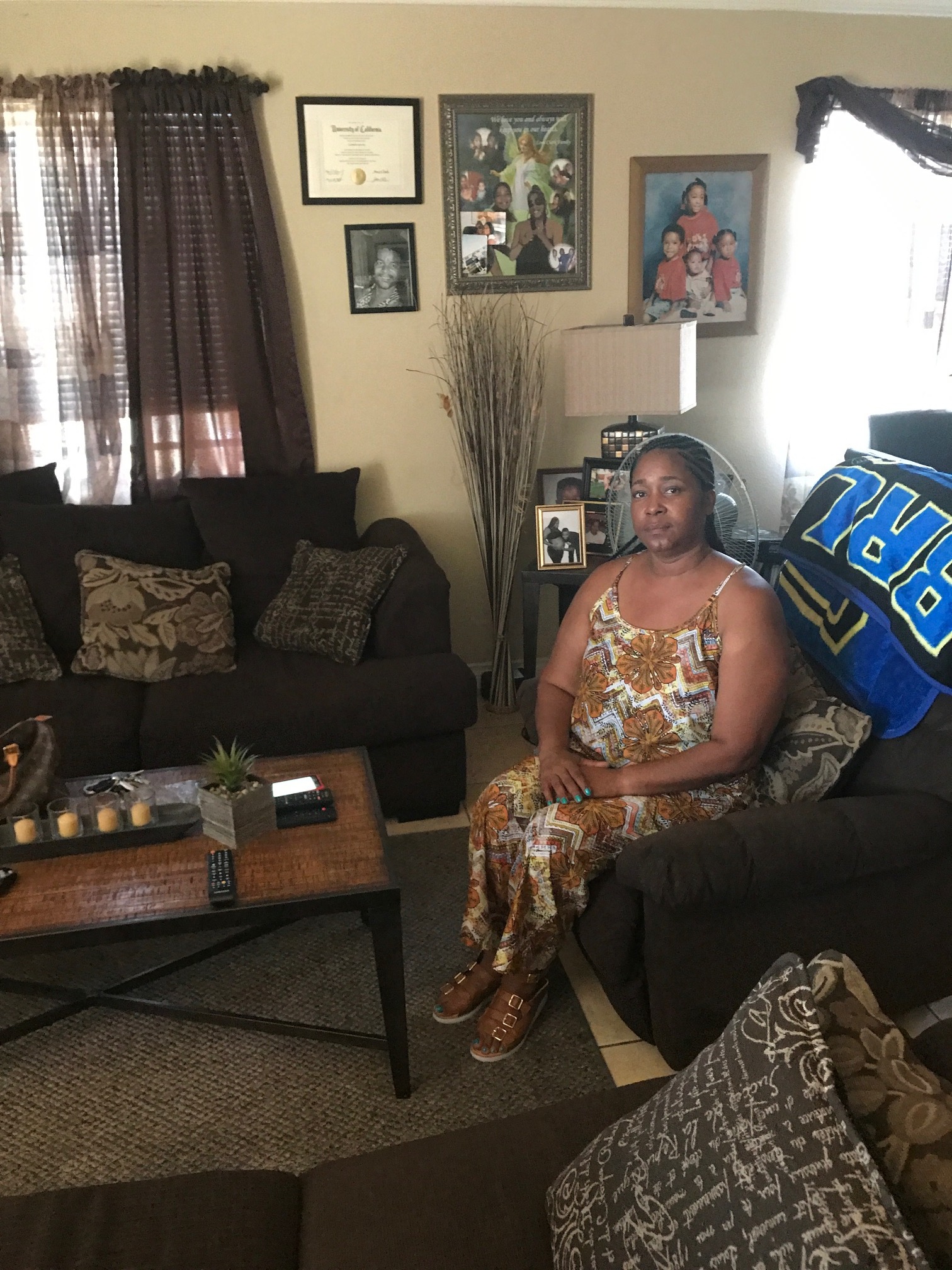As A City Mourns Nipsey Hussle In The Staples Center, A Family Mourns Maurice Forte In Nickerson Gardens
/Josiah Walker stayed up late Saturday night - past midnight into Sunday morning -because that day, April 7th, was a big deal to him. It was his 10th birthday. Not long after he turned 10, Josiah heard three gunshots. He was in Nickerson Gardens, Watts, a place long accustomed to the wicked sound.
His mother, Jacqueline, a bit hard of hearing. didn’t hear the shots, but she soon heard the commotion at the front door of her unit. Justice, the 17 year-old girlfriend of her son Maurice Forte, 18, was there in full distress. Maurice had just been shot.
Jacqueline ran outside, to Imperial Highway near Parmelee Avenue, to a metal gate entrance along the sidewalk of the projects, and saw that worst sight a mother could see; Her son’s lifeless body, three red holes on his sweatshirt.
As the city today focused on the death of beloved rapper Nipsey Hussle, as peace marches spurned by his shooting have attracted thousands to Crenshaw and Slauson and lead the local news, the struggles of Watts went on almost unnoticed west of Central Avenue.
But, here, inside Watts, the pain was as unbearable as ever.
A nearly lifelong Nickerson Gardens female resident who goes by the name Red led me to Maurice’s mother’s apartment. Red used to live next door and knew the slain boy when he was yay high.
Jacqueline Walker comes to the front door to meet us. She is not in tears. She is not red-eyed. She seems, actually, kind of drained of emotion. As if the last two days she’s been in Zombieland. It’s not that she’s medicated, it’s just that she’s so brokenhearted her emotions have run dry.
Red hugs her. She looks at me and, before I even say a word, she politely says “I just want to let you know there are no words of comfort that can make me feel better. There are no words.”
So I say nothing, in hopes she will continue, maybe start talking about her son without a prompt. She doesn’t.
In an effort to obtain instant credibility, I tell her “I’ve been covering Watts for close to 30 years. I’m old friends with Kartoon and with Loaf.”
She looks at me blankly. Kartoon, I repeat. Loaf, Nothing. No reaction. “You don’t know of Kartoon or Loaf,” I asked, mentioning two legendary men around these parts. She shakes her head, in an almost embarrassed way.
Red bursts into laughter. “That right there shows you how square she is. You live in Nickerson Gardens and don’t know Kartoon or Loaf? Girl, you gotta be the squarest lady up in here.” Red burst into laughter. And, almost certainly for the first time in over 48 hours, so does Jacqueline.
It turns out this “Kartoon”, whose name is Ronald Antwine, came across the crime scene almost immediately after it occurred.
“Moe was already dead,” Kartoon said as he stood in front of the Nickerson Gardens gym, famous for a small mural that says “Nobody Can Stop This War But Us” and larger ones listing the names of residents who have died, both naturally and violently.
Antwine had been at a friend’s party earlier Saturday night. Here is some of what he wrote to me later;
“I went to my lifelong friend Greg’s 60th birthday party, The odds were stacked against us to live a full life years ago. I sat and partied with my O.G’s and the reunion was priceless.
“I left that party and went to another where I sat with an O.G. who, at one time, would have been labeled as my enemy. We talk about, not only Nipsey Hussle’s murder, but the gang culture here in Watts and South Central. We both acknowledged the lack of respect many youngsters display, the disloyalty and the devaluation of life. After a lengthy conversation we parted ways in the hopes of ending our night peacefully.
“In less than 10 minutes the uplifted spirit of mine fell from its heights, my emotions became unstable, my life felt so empty. A few seconds in front of me an act of cowardice took place, I pulled over knowing I couldn’t render any assistance. I watched a young man take his last breath.”
“I feel bad about Nip, It’s a tragedy. But, his funeral gonna be at Staples Center and the whole city will be watching and grieving. What about the family here grieving for their kid.”
.“I’m tired, just simply tired of what has become just another day in the hood.”
The LAPD would only say their investigation is continuing.
“We’re working on a few thing, but we’re in the infancy of the investigation,” said Det. Arron Harrington of LAPD’s South Bureau Homicide.
Since the killing, as is common after a shooting, rumors have been rampant and Harrington doesn’t want to encourage more. A video even briefly surfaced on Facebook of the fallen young man.
Back at Jacqueline’s, her and Red stood at the entrance of the two units, an area maybe 15 square feet. This was Moe’s childhood playground, they say. His family wouldn’t let him venture out into the projects, home of the Bounty Hunter Bloods, one of America’s most infamous street gangs.
Maurice’s confinement didn’t last. After being bussed to middle school, the small confines of the porch was no longer possible and Moe started to hang out. In short time, he was getting into trouble. He did time in juvenile camp for being a look out on a burglary, a crime that both his mother and Red had another laugh about.
“I don’t even think he knew what he was doing,” said Red. “He was supposed to be a look out on a burglary and he was playing on the phone when the police drove by. He sure couldn’t be my lookout when I was robbing banks.”
Soon, Maurice had sprouted to 6-foot, 1” and became known in some circle as “Big Moe”. His troubles continued and he, while not a ruthless hard core killer, would end up in camp or juvenile hall, usually for a failure to appear that a warrant had been issued for. “Everyone around here would remember him as a good kid,” said Red. “But, in Nickerson Gardens, you can’t help but know your neighbors and if they happen to be Bounty Hunters, you just can’t ignore them.”
Jacqueline suddenly remembers his probation officers, a Mrs. Grimes from the Compton office. “She is going to be devastated. She was very kind to Maurice.”
It’s often hard for people, even if they live here in, say, West L.A. or Encino to understand or even give a damn when a gang member dies. The first, knee jerk response is usually “Well, he was a gang member. What did he expect?” What, they don’t understand is in some places it’s safer, certainly easier to be in a gang than not. And being in a gang doesn’t make you a killer. In the city’s most notorious gangs; Bounty Hunters, Grape Street, Rollin’ 60s, Hoover Criminals, shot callers have told me the vast majority – up to 90, 95% - are not “true riders”, the hard core who “put in work” for the gang.
Still, the newspapers are full of two word biographies - “gang member” – to describe the life of a countless homicide victims. But, who was that person?
Maurice’s girlfriend, Justice, who was with him when he was killed as they were walking to a market, said she met him three years ago when she was only 14.. “Months later, he asked me to be his girlfriend.”
Justice in a soft, barely audible voice, spoke of his gentleness, his thoughtfulness.
“I never expected him to do half of things he did for me. If I needed to talk, he wanted to listen. He wouldn’t butt in and say something, he would let me talk. He was always there for me.”
Later, Justice texted me the following
“I have something else I want to add. He was the first boy to meet my father and my father loved him so. That made me love him even more. Maurice was such an adventure. We were always happy. I love him and I will forever cherish him in my heart.”
Reached by phone, Moe’s sister Kiearra can’t speak other than to say “This is about to be hard.” She hands the phone to another brother, Jahmile.
“He was a loving person,” Jahmiel Forte, Jr. said “He would never want to hurt anyone. He was all about family. He loved music. Loved rap. We’d sing together.”
Thinking, reaching for some sap, that I might get an ironic Nipsey Hussle shout-out, I ask “Who was his favorite rapper?’
“Himself,” said his sister Kiearra, returning to the phone. “He was his favorite rapper. Only thing, was he never go to finish a song.”
Another sister, Janae, Forte, 20. said her brother was always smiling and would never let anyone know if he was down.
“There was never a day when he showed anger or sadness,” she said. “If he ever was, no one knew because he would keep it to himself.”
Back in Nickerson Gardens, his mother talked about his dreams of becoming in the music business and getting out of this neighborhood.
“He wanted to go someplace peaceful,” said Jacqueline. She said that three more times. Each time a little softer, almost like she was thinking -or at least hoping – he is there now.










